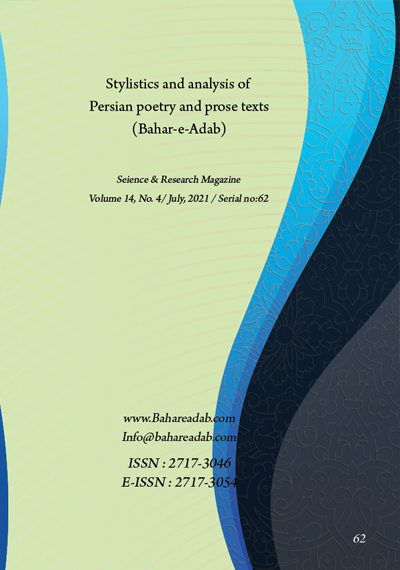- Count View : 427
- آدرس کوتاه شده مقاله: https://bahareadab.com/article_id/1110
- کد doi مقاله: Doi: 10.22034/bahareadab.2021 .14 .5464
Journal of the stylistic of Persian poem and prose
volume Number 14،
number In Volume 4،
،
issue Number 62
Imaging by four elements in Ferdosi’s Shahnameh
Zhaleh Afshar Qazvin , Hamidreza Arsdestani Rostami (Author in Charge), Sareh Zirak
Abstract
BACKGROUND AND OBJECTIVES: The four elements have always played a significant role among the sciences, beliefs and myths of various nations and cultures and have been the source of the emergence of certain ideas, thoughts and works. These elements have not been neglected in the field of literature and have been widely and artistically expressed. One of the works in which the four elements are remarkable in terms of frequency, artistic effects and poetic illustration is Ferdowsi"s Shahnameh. Ferdowsi had a special tendency to use the four elements to highlight his speech and artistic expression. In this paper, the frequency and how to use four elements in the illustrations of this work has been studied. The main question of the research is that in what way and how did Ferdowsi use the four elements in creating imaginary images?
METHODOLOGY: The research method in this article is descriptive-analytical and the data collection method is documentary (library)
FINDINGS: Ferdowsi has repeated the four elements in Shahnameh about 2688 times. Of these, 939 words are related to water (35%), 722 words are related to soil (27%), 598 words are related to wind (22%) and 429 words (16%) are related to fire. There are 12 verses in Shahnameh in which All four elements come together. Also, in 10 bits, three elements and in 51 bits, two elements are accompanied.
CONCLUSION: The most frequent elements in Shahnameh are water, soil, wind and fire, respectively. Also, most of the poetic images in this field are created in metaphorical structure and the share of expression techniques is much more than novel techniques.
Keyword
Imaging by four elements in Ferdosi’s Shahnameh
- Afifi, Rahim. (2004). Iranian mythology and culture in the writings of Pahlavi, Second Edition, Tehran: Toos, p. 402.
- Akhawayni Bukhari, Abu Bakr Rabi 'Ibn Ahmad. (1993). Hedayat al-Mutalimin fi al-Tib, by Jalal Matini, Second Edition, Mashhad: Ferdowsi University, p. 25.
- Barbarian, Manuel. (1997). An Inquiry into the Background of the Knowledge of the Universe and the Earth in Iran Vij, Tehran: Balkh, p. 116.
- Dehkhoda, Ali Akbar. (1967). Dictionary, Various volumes, Tehran: University of Tehran Press.
- Ferdowsi, Abolghasem. (2020). Shahnameh, Correction of Jalal Khaleghi Motlagh, 4 volumes, Tehran: Sokhan.
- Ghaemi, Farzad and Others. (2009). Symbolic Analysis of Soil and Wind Elements in Ferdowsi Myths and Shahnameh Based on Mythical Criticism, Literature Research, No. 10, Winter, pp. 57-82.
- Hadi, Sohrab. (1998). Understanding the Myths of Nations, Tehran: Tandis, p. 246.
- Hinels, John Russell. (2004). Understanding Iranian Mythology, Translated by Mohammad Hossein Bajlan, Tehran: Mythology, p. 75.
- Ibn Sina, Abu Ali Al-Hussein Ibn Ali. (1993). Law in Medicine, Volume 1, Beirut: Izz al-Din Printing and Publisher Foundation. P. 488.
- Mehrin, Mehrdad. (1964). Philosophy of the East, Fourth Edition, Tehran: Ataei Press Institute, p 234.
- Nezami Aroozi Samarqandi, Ahmad Ibn Omar. (2009). 4 maqale (Four articles), edited by Mohammad Qazvini and the efforts of Mohammad Moein, Tehran: Zavvar, p. 104.
- Oshidari, Jahangir. (1993). Tehran: Markaz Publisher, p. 51.
- Plato. (2001). Timaeus, Translated by Mohammad Hassan Lotfi, Volume 3, Tehran: Kharazmi, p. 38.
- Rizi, Ismail Ibn Mohammad. (1991). Philosophy of Enlightenment in Persian, Tehran: Collection of Literary and Historical Publications, p. 215.
- Serlo, Juan Eduardo. (2010). Culture of Symbols, Translated by Mehrangiz Ouhadi, Tehran: Dastan, p. 91.
- Yahaghi, Mohammad Jafar. (2007). Culture of Myths and Stories in Persian Literature, Tehran: Contemporary Culture in collaboration with Soroush, p. 191.

